Climate Change: Impacts of 1.5°C and 2°C Temperature Increases Report
VerifiedAdded on 2022/10/04
|8
|2226
|13
Report
AI Summary
This report delves into the critical issue of climate change, examining the implications of the Paris Agreement's temperature goals of 1.5°C and 2°C above pre-industrial levels. It explores how these limits were determined and their global impacts, including identifying countries that stand to lose the most and those that might benefit. The report analyzes the differences in terms of impacts under the two temperature scenarios, considering factors like extreme weather events, precipitation changes, and impacts on agriculture. Additionally, the report investigates the feasibility of limiting the global mean temperature increase to either 1.5°C or 2°C, supported by peer-reviewed scientific literature, including the IPCC report and several published research articles. The report also assesses the political and social feasibility of achieving these temperature targets, emphasizing the need for urgent decarbonization and social justice.
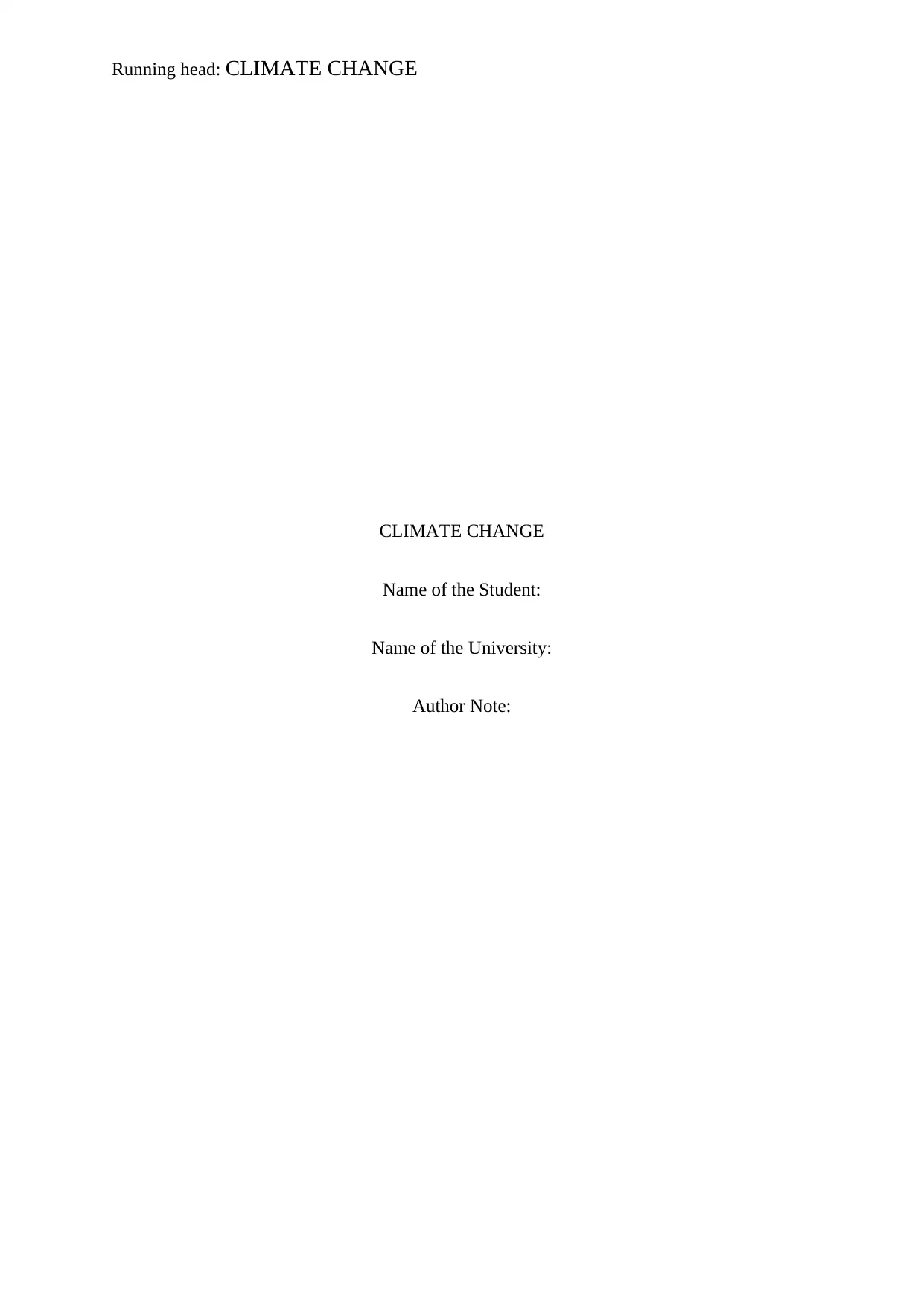
Running head: CLIMATE CHANGE
CLIMATE CHANGE
Name of the Student:
Name of the University:
Author Note:
CLIMATE CHANGE
Name of the Student:
Name of the University:
Author Note:
Paraphrase This Document
Need a fresh take? Get an instant paraphrase of this document with our AI Paraphraser
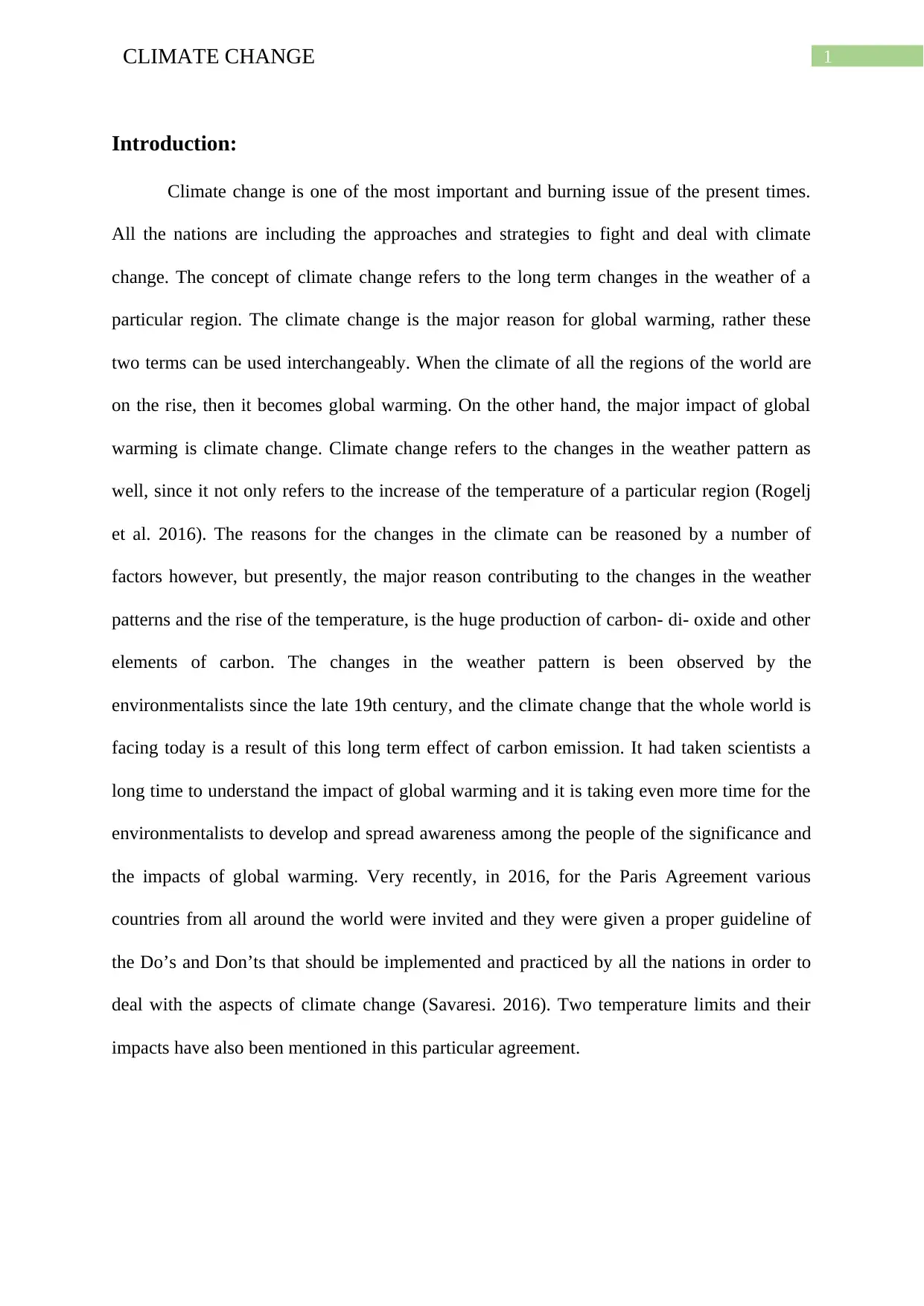
1CLIMATE CHANGE
Introduction:
Climate change is one of the most important and burning issue of the present times.
All the nations are including the approaches and strategies to fight and deal with climate
change. The concept of climate change refers to the long term changes in the weather of a
particular region. The climate change is the major reason for global warming, rather these
two terms can be used interchangeably. When the climate of all the regions of the world are
on the rise, then it becomes global warming. On the other hand, the major impact of global
warming is climate change. Climate change refers to the changes in the weather pattern as
well, since it not only refers to the increase of the temperature of a particular region (Rogelj
et al. 2016). The reasons for the changes in the climate can be reasoned by a number of
factors however, but presently, the major reason contributing to the changes in the weather
patterns and the rise of the temperature, is the huge production of carbon- di- oxide and other
elements of carbon. The changes in the weather pattern is been observed by the
environmentalists since the late 19th century, and the climate change that the whole world is
facing today is a result of this long term effect of carbon emission. It had taken scientists a
long time to understand the impact of global warming and it is taking even more time for the
environmentalists to develop and spread awareness among the people of the significance and
the impacts of global warming. Very recently, in 2016, for the Paris Agreement various
countries from all around the world were invited and they were given a proper guideline of
the Do’s and Don’ts that should be implemented and practiced by all the nations in order to
deal with the aspects of climate change (Savaresi. 2016). Two temperature limits and their
impacts have also been mentioned in this particular agreement.
Introduction:
Climate change is one of the most important and burning issue of the present times.
All the nations are including the approaches and strategies to fight and deal with climate
change. The concept of climate change refers to the long term changes in the weather of a
particular region. The climate change is the major reason for global warming, rather these
two terms can be used interchangeably. When the climate of all the regions of the world are
on the rise, then it becomes global warming. On the other hand, the major impact of global
warming is climate change. Climate change refers to the changes in the weather pattern as
well, since it not only refers to the increase of the temperature of a particular region (Rogelj
et al. 2016). The reasons for the changes in the climate can be reasoned by a number of
factors however, but presently, the major reason contributing to the changes in the weather
patterns and the rise of the temperature, is the huge production of carbon- di- oxide and other
elements of carbon. The changes in the weather pattern is been observed by the
environmentalists since the late 19th century, and the climate change that the whole world is
facing today is a result of this long term effect of carbon emission. It had taken scientists a
long time to understand the impact of global warming and it is taking even more time for the
environmentalists to develop and spread awareness among the people of the significance and
the impacts of global warming. Very recently, in 2016, for the Paris Agreement various
countries from all around the world were invited and they were given a proper guideline of
the Do’s and Don’ts that should be implemented and practiced by all the nations in order to
deal with the aspects of climate change (Savaresi. 2016). Two temperature limits and their
impacts have also been mentioned in this particular agreement.
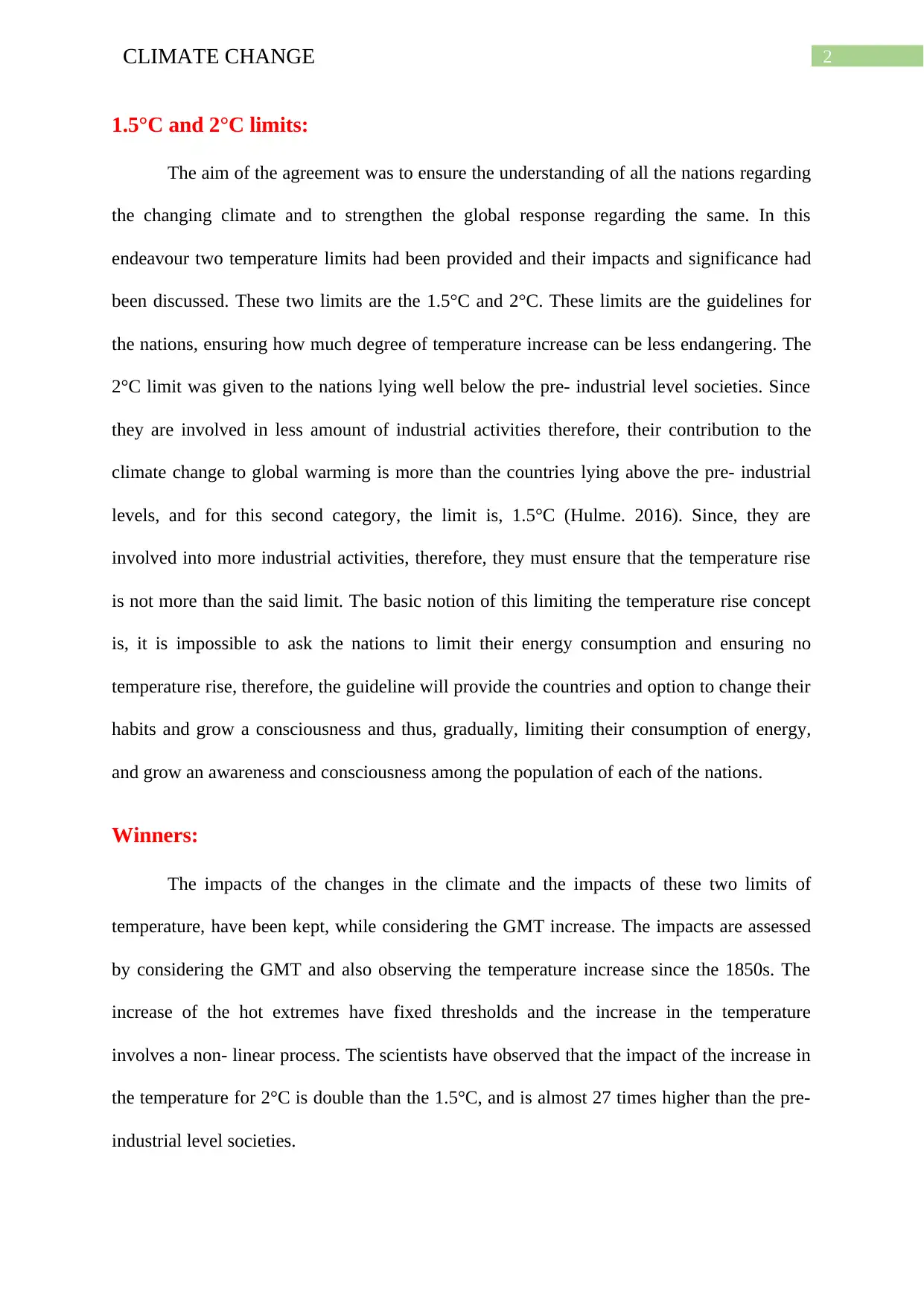
2CLIMATE CHANGE
1.5°C and 2°C limits:
The aim of the agreement was to ensure the understanding of all the nations regarding
the changing climate and to strengthen the global response regarding the same. In this
endeavour two temperature limits had been provided and their impacts and significance had
been discussed. These two limits are the 1.5°C and 2°C. These limits are the guidelines for
the nations, ensuring how much degree of temperature increase can be less endangering. The
2°C limit was given to the nations lying well below the pre- industrial level societies. Since
they are involved in less amount of industrial activities therefore, their contribution to the
climate change to global warming is more than the countries lying above the pre- industrial
levels, and for this second category, the limit is, 1.5°C (Hulme. 2016). Since, they are
involved into more industrial activities, therefore, they must ensure that the temperature rise
is not more than the said limit. The basic notion of this limiting the temperature rise concept
is, it is impossible to ask the nations to limit their energy consumption and ensuring no
temperature rise, therefore, the guideline will provide the countries and option to change their
habits and grow a consciousness and thus, gradually, limiting their consumption of energy,
and grow an awareness and consciousness among the population of each of the nations.
Winners:
The impacts of the changes in the climate and the impacts of these two limits of
temperature, have been kept, while considering the GMT increase. The impacts are assessed
by considering the GMT and also observing the temperature increase since the 1850s. The
increase of the hot extremes have fixed thresholds and the increase in the temperature
involves a non- linear process. The scientists have observed that the impact of the increase in
the temperature for 2°C is double than the 1.5°C, and is almost 27 times higher than the pre-
industrial level societies.
1.5°C and 2°C limits:
The aim of the agreement was to ensure the understanding of all the nations regarding
the changing climate and to strengthen the global response regarding the same. In this
endeavour two temperature limits had been provided and their impacts and significance had
been discussed. These two limits are the 1.5°C and 2°C. These limits are the guidelines for
the nations, ensuring how much degree of temperature increase can be less endangering. The
2°C limit was given to the nations lying well below the pre- industrial level societies. Since
they are involved in less amount of industrial activities therefore, their contribution to the
climate change to global warming is more than the countries lying above the pre- industrial
levels, and for this second category, the limit is, 1.5°C (Hulme. 2016). Since, they are
involved into more industrial activities, therefore, they must ensure that the temperature rise
is not more than the said limit. The basic notion of this limiting the temperature rise concept
is, it is impossible to ask the nations to limit their energy consumption and ensuring no
temperature rise, therefore, the guideline will provide the countries and option to change their
habits and grow a consciousness and thus, gradually, limiting their consumption of energy,
and grow an awareness and consciousness among the population of each of the nations.
Winners:
The impacts of the changes in the climate and the impacts of these two limits of
temperature, have been kept, while considering the GMT increase. The impacts are assessed
by considering the GMT and also observing the temperature increase since the 1850s. The
increase of the hot extremes have fixed thresholds and the increase in the temperature
involves a non- linear process. The scientists have observed that the impact of the increase in
the temperature for 2°C is double than the 1.5°C, and is almost 27 times higher than the pre-
industrial level societies.
⊘ This is a preview!⊘
Do you want full access?
Subscribe today to unlock all pages.

Trusted by 1+ million students worldwide
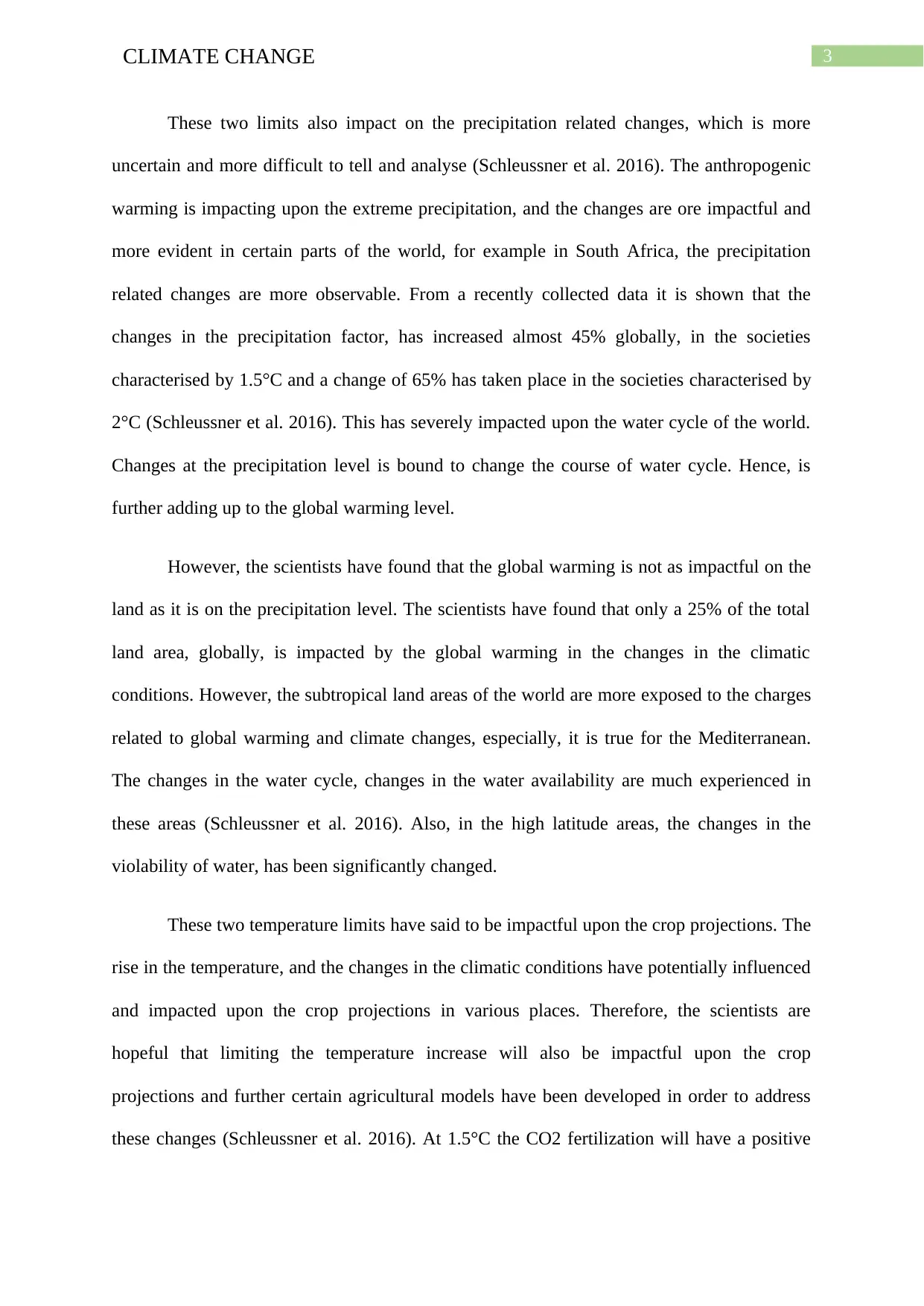
3CLIMATE CHANGE
These two limits also impact on the precipitation related changes, which is more
uncertain and more difficult to tell and analyse (Schleussner et al. 2016). The anthropogenic
warming is impacting upon the extreme precipitation, and the changes are ore impactful and
more evident in certain parts of the world, for example in South Africa, the precipitation
related changes are more observable. From a recently collected data it is shown that the
changes in the precipitation factor, has increased almost 45% globally, in the societies
characterised by 1.5°C and a change of 65% has taken place in the societies characterised by
2°C (Schleussner et al. 2016). This has severely impacted upon the water cycle of the world.
Changes at the precipitation level is bound to change the course of water cycle. Hence, is
further adding up to the global warming level.
However, the scientists have found that the global warming is not as impactful on the
land as it is on the precipitation level. The scientists have found that only a 25% of the total
land area, globally, is impacted by the global warming in the changes in the climatic
conditions. However, the subtropical land areas of the world are more exposed to the charges
related to global warming and climate changes, especially, it is true for the Mediterranean.
The changes in the water cycle, changes in the water availability are much experienced in
these areas (Schleussner et al. 2016). Also, in the high latitude areas, the changes in the
violability of water, has been significantly changed.
These two temperature limits have said to be impactful upon the crop projections. The
rise in the temperature, and the changes in the climatic conditions have potentially influenced
and impacted upon the crop projections in various places. Therefore, the scientists are
hopeful that limiting the temperature increase will also be impactful upon the crop
projections and further certain agricultural models have been developed in order to address
these changes (Schleussner et al. 2016). At 1.5°C the CO2 fertilization will have a positive
These two limits also impact on the precipitation related changes, which is more
uncertain and more difficult to tell and analyse (Schleussner et al. 2016). The anthropogenic
warming is impacting upon the extreme precipitation, and the changes are ore impactful and
more evident in certain parts of the world, for example in South Africa, the precipitation
related changes are more observable. From a recently collected data it is shown that the
changes in the precipitation factor, has increased almost 45% globally, in the societies
characterised by 1.5°C and a change of 65% has taken place in the societies characterised by
2°C (Schleussner et al. 2016). This has severely impacted upon the water cycle of the world.
Changes at the precipitation level is bound to change the course of water cycle. Hence, is
further adding up to the global warming level.
However, the scientists have found that the global warming is not as impactful on the
land as it is on the precipitation level. The scientists have found that only a 25% of the total
land area, globally, is impacted by the global warming in the changes in the climatic
conditions. However, the subtropical land areas of the world are more exposed to the charges
related to global warming and climate changes, especially, it is true for the Mediterranean.
The changes in the water cycle, changes in the water availability are much experienced in
these areas (Schleussner et al. 2016). Also, in the high latitude areas, the changes in the
violability of water, has been significantly changed.
These two temperature limits have said to be impactful upon the crop projections. The
rise in the temperature, and the changes in the climatic conditions have potentially influenced
and impacted upon the crop projections in various places. Therefore, the scientists are
hopeful that limiting the temperature increase will also be impactful upon the crop
projections and further certain agricultural models have been developed in order to address
these changes (Schleussner et al. 2016). At 1.5°C the CO2 fertilization will have a positive
Paraphrase This Document
Need a fresh take? Get an instant paraphrase of this document with our AI Paraphraser
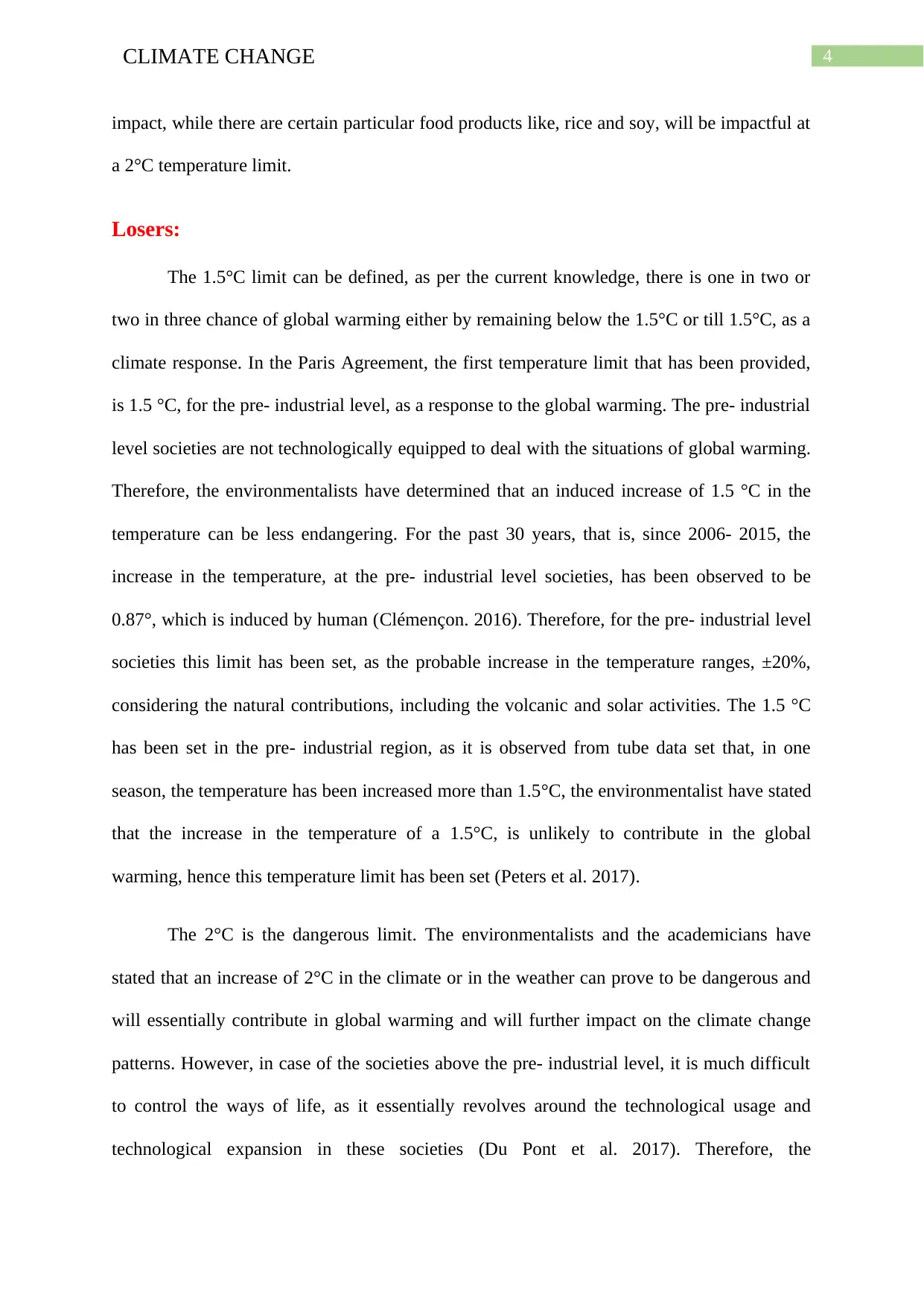
4CLIMATE CHANGE
impact, while there are certain particular food products like, rice and soy, will be impactful at
a 2°C temperature limit.
Losers:
The 1.5°C limit can be defined, as per the current knowledge, there is one in two or
two in three chance of global warming either by remaining below the 1.5°C or till 1.5°C, as a
climate response. In the Paris Agreement, the first temperature limit that has been provided,
is 1.5 °C, for the pre- industrial level, as a response to the global warming. The pre- industrial
level societies are not technologically equipped to deal with the situations of global warming.
Therefore, the environmentalists have determined that an induced increase of 1.5 °C in the
temperature can be less endangering. For the past 30 years, that is, since 2006- 2015, the
increase in the temperature, at the pre- industrial level societies, has been observed to be
0.87°, which is induced by human (Clémençon. 2016). Therefore, for the pre- industrial level
societies this limit has been set, as the probable increase in the temperature ranges, ±20%,
considering the natural contributions, including the volcanic and solar activities. The 1.5 °C
has been set in the pre- industrial region, as it is observed from tube data set that, in one
season, the temperature has been increased more than 1.5°C, the environmentalist have stated
that the increase in the temperature of a 1.5°C, is unlikely to contribute in the global
warming, hence this temperature limit has been set (Peters et al. 2017).
The 2°C is the dangerous limit. The environmentalists and the academicians have
stated that an increase of 2°C in the climate or in the weather can prove to be dangerous and
will essentially contribute in global warming and will further impact on the climate change
patterns. However, in case of the societies above the pre- industrial level, it is much difficult
to control the ways of life, as it essentially revolves around the technological usage and
technological expansion in these societies (Du Pont et al. 2017). Therefore, the
impact, while there are certain particular food products like, rice and soy, will be impactful at
a 2°C temperature limit.
Losers:
The 1.5°C limit can be defined, as per the current knowledge, there is one in two or
two in three chance of global warming either by remaining below the 1.5°C or till 1.5°C, as a
climate response. In the Paris Agreement, the first temperature limit that has been provided,
is 1.5 °C, for the pre- industrial level, as a response to the global warming. The pre- industrial
level societies are not technologically equipped to deal with the situations of global warming.
Therefore, the environmentalists have determined that an induced increase of 1.5 °C in the
temperature can be less endangering. For the past 30 years, that is, since 2006- 2015, the
increase in the temperature, at the pre- industrial level societies, has been observed to be
0.87°, which is induced by human (Clémençon. 2016). Therefore, for the pre- industrial level
societies this limit has been set, as the probable increase in the temperature ranges, ±20%,
considering the natural contributions, including the volcanic and solar activities. The 1.5 °C
has been set in the pre- industrial region, as it is observed from tube data set that, in one
season, the temperature has been increased more than 1.5°C, the environmentalist have stated
that the increase in the temperature of a 1.5°C, is unlikely to contribute in the global
warming, hence this temperature limit has been set (Peters et al. 2017).
The 2°C is the dangerous limit. The environmentalists and the academicians have
stated that an increase of 2°C in the climate or in the weather can prove to be dangerous and
will essentially contribute in global warming and will further impact on the climate change
patterns. However, in case of the societies above the pre- industrial level, it is much difficult
to control the ways of life, as it essentially revolves around the technological usage and
technological expansion in these societies (Du Pont et al. 2017). Therefore, the
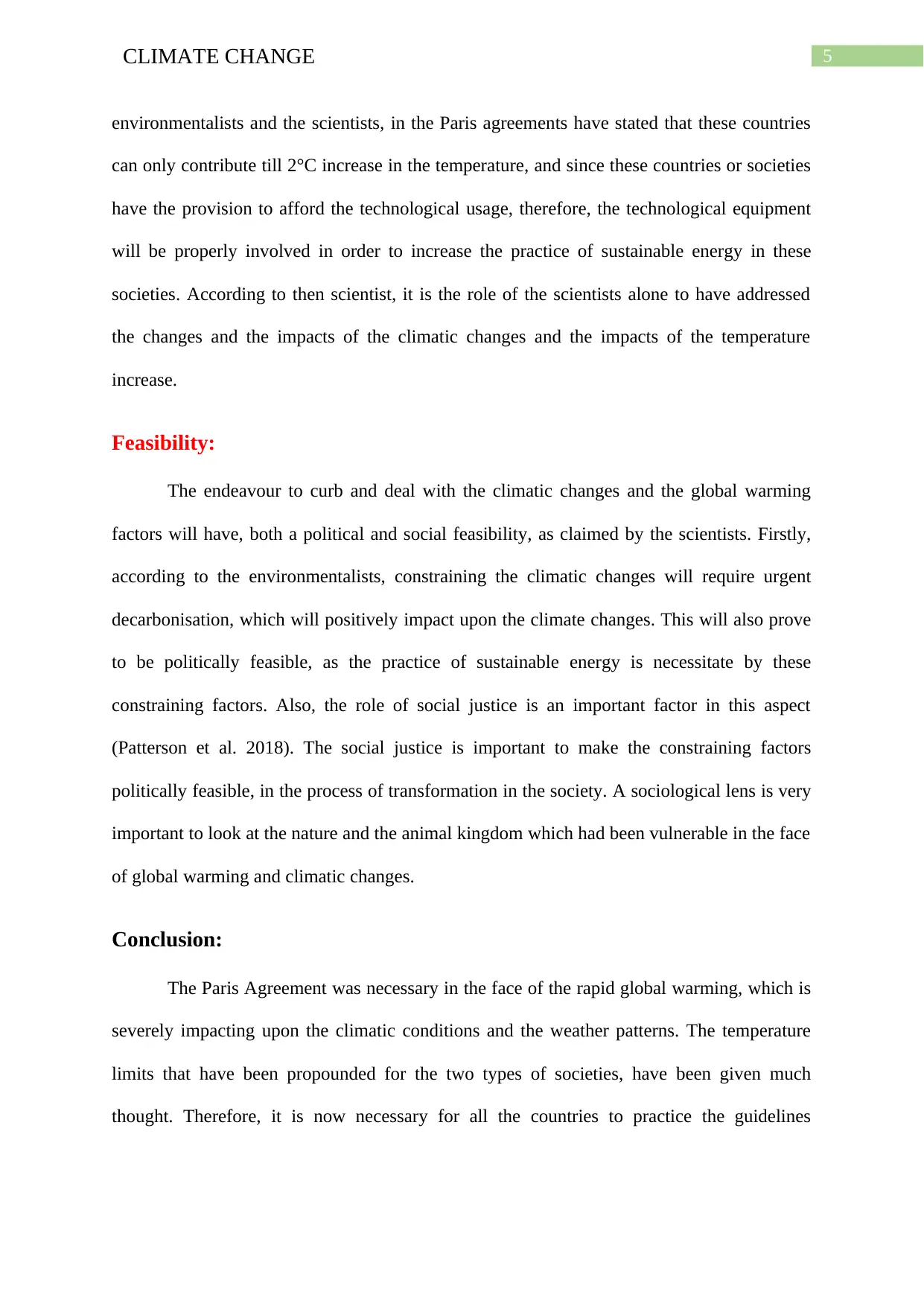
5CLIMATE CHANGE
environmentalists and the scientists, in the Paris agreements have stated that these countries
can only contribute till 2°C increase in the temperature, and since these countries or societies
have the provision to afford the technological usage, therefore, the technological equipment
will be properly involved in order to increase the practice of sustainable energy in these
societies. According to then scientist, it is the role of the scientists alone to have addressed
the changes and the impacts of the climatic changes and the impacts of the temperature
increase.
Feasibility:
The endeavour to curb and deal with the climatic changes and the global warming
factors will have, both a political and social feasibility, as claimed by the scientists. Firstly,
according to the environmentalists, constraining the climatic changes will require urgent
decarbonisation, which will positively impact upon the climate changes. This will also prove
to be politically feasible, as the practice of sustainable energy is necessitate by these
constraining factors. Also, the role of social justice is an important factor in this aspect
(Patterson et al. 2018). The social justice is important to make the constraining factors
politically feasible, in the process of transformation in the society. A sociological lens is very
important to look at the nature and the animal kingdom which had been vulnerable in the face
of global warming and climatic changes.
Conclusion:
The Paris Agreement was necessary in the face of the rapid global warming, which is
severely impacting upon the climatic conditions and the weather patterns. The temperature
limits that have been propounded for the two types of societies, have been given much
thought. Therefore, it is now necessary for all the countries to practice the guidelines
environmentalists and the scientists, in the Paris agreements have stated that these countries
can only contribute till 2°C increase in the temperature, and since these countries or societies
have the provision to afford the technological usage, therefore, the technological equipment
will be properly involved in order to increase the practice of sustainable energy in these
societies. According to then scientist, it is the role of the scientists alone to have addressed
the changes and the impacts of the climatic changes and the impacts of the temperature
increase.
Feasibility:
The endeavour to curb and deal with the climatic changes and the global warming
factors will have, both a political and social feasibility, as claimed by the scientists. Firstly,
according to the environmentalists, constraining the climatic changes will require urgent
decarbonisation, which will positively impact upon the climate changes. This will also prove
to be politically feasible, as the practice of sustainable energy is necessitate by these
constraining factors. Also, the role of social justice is an important factor in this aspect
(Patterson et al. 2018). The social justice is important to make the constraining factors
politically feasible, in the process of transformation in the society. A sociological lens is very
important to look at the nature and the animal kingdom which had been vulnerable in the face
of global warming and climatic changes.
Conclusion:
The Paris Agreement was necessary in the face of the rapid global warming, which is
severely impacting upon the climatic conditions and the weather patterns. The temperature
limits that have been propounded for the two types of societies, have been given much
thought. Therefore, it is now necessary for all the countries to practice the guidelines
⊘ This is a preview!⊘
Do you want full access?
Subscribe today to unlock all pages.

Trusted by 1+ million students worldwide
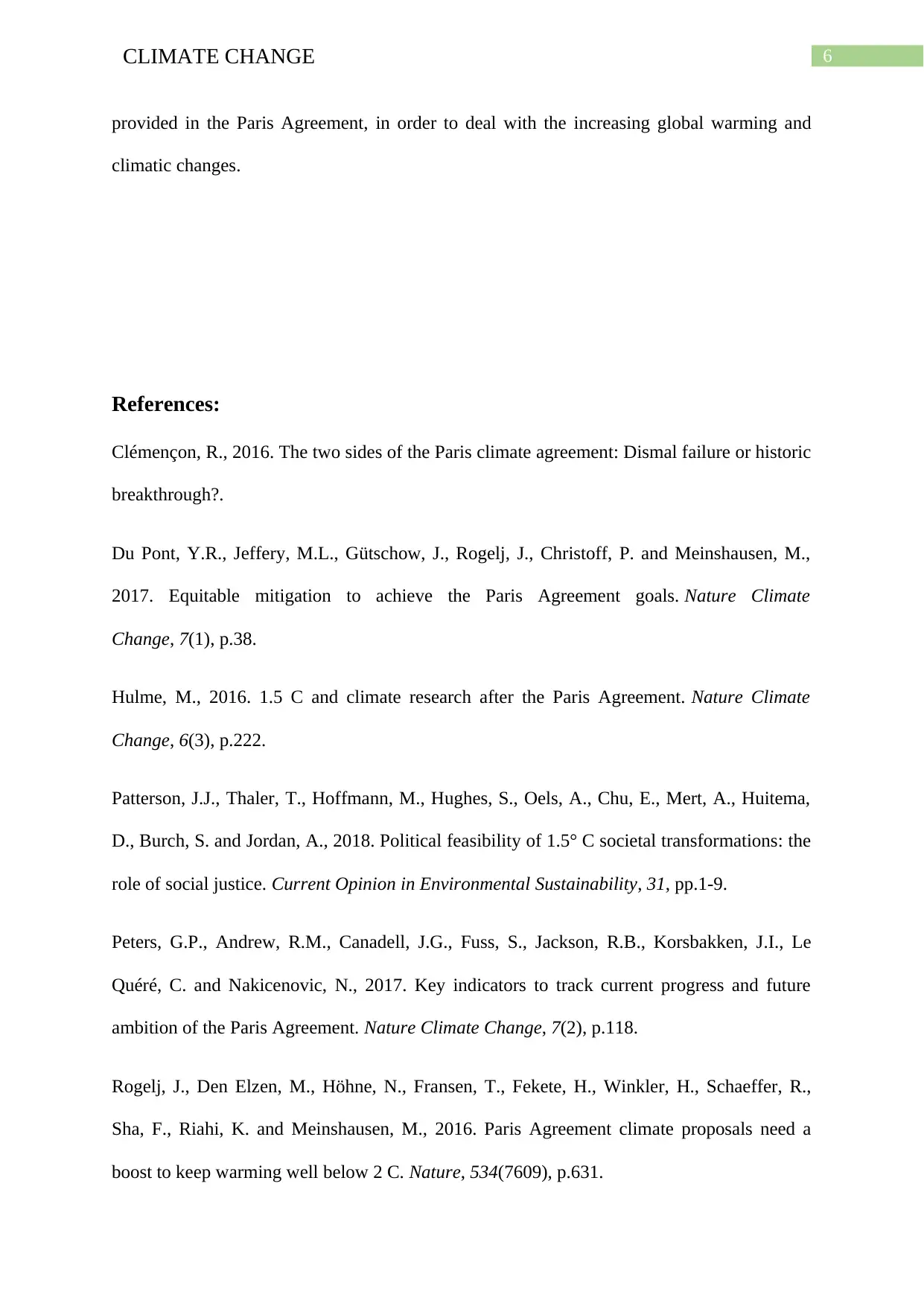
6CLIMATE CHANGE
provided in the Paris Agreement, in order to deal with the increasing global warming and
climatic changes.
References:
Clémençon, R., 2016. The two sides of the Paris climate agreement: Dismal failure or historic
breakthrough?.
Du Pont, Y.R., Jeffery, M.L., Gütschow, J., Rogelj, J., Christoff, P. and Meinshausen, M.,
2017. Equitable mitigation to achieve the Paris Agreement goals. Nature Climate
Change, 7(1), p.38.
Hulme, M., 2016. 1.5 C and climate research after the Paris Agreement. Nature Climate
Change, 6(3), p.222.
Patterson, J.J., Thaler, T., Hoffmann, M., Hughes, S., Oels, A., Chu, E., Mert, A., Huitema,
D., Burch, S. and Jordan, A., 2018. Political feasibility of 1.5° C societal transformations: the
role of social justice. Current Opinion in Environmental Sustainability, 31, pp.1-9.
Peters, G.P., Andrew, R.M., Canadell, J.G., Fuss, S., Jackson, R.B., Korsbakken, J.I., Le
Quéré, C. and Nakicenovic, N., 2017. Key indicators to track current progress and future
ambition of the Paris Agreement. Nature Climate Change, 7(2), p.118.
Rogelj, J., Den Elzen, M., Höhne, N., Fransen, T., Fekete, H., Winkler, H., Schaeffer, R.,
Sha, F., Riahi, K. and Meinshausen, M., 2016. Paris Agreement climate proposals need a
boost to keep warming well below 2 C. Nature, 534(7609), p.631.
provided in the Paris Agreement, in order to deal with the increasing global warming and
climatic changes.
References:
Clémençon, R., 2016. The two sides of the Paris climate agreement: Dismal failure or historic
breakthrough?.
Du Pont, Y.R., Jeffery, M.L., Gütschow, J., Rogelj, J., Christoff, P. and Meinshausen, M.,
2017. Equitable mitigation to achieve the Paris Agreement goals. Nature Climate
Change, 7(1), p.38.
Hulme, M., 2016. 1.5 C and climate research after the Paris Agreement. Nature Climate
Change, 6(3), p.222.
Patterson, J.J., Thaler, T., Hoffmann, M., Hughes, S., Oels, A., Chu, E., Mert, A., Huitema,
D., Burch, S. and Jordan, A., 2018. Political feasibility of 1.5° C societal transformations: the
role of social justice. Current Opinion in Environmental Sustainability, 31, pp.1-9.
Peters, G.P., Andrew, R.M., Canadell, J.G., Fuss, S., Jackson, R.B., Korsbakken, J.I., Le
Quéré, C. and Nakicenovic, N., 2017. Key indicators to track current progress and future
ambition of the Paris Agreement. Nature Climate Change, 7(2), p.118.
Rogelj, J., Den Elzen, M., Höhne, N., Fransen, T., Fekete, H., Winkler, H., Schaeffer, R.,
Sha, F., Riahi, K. and Meinshausen, M., 2016. Paris Agreement climate proposals need a
boost to keep warming well below 2 C. Nature, 534(7609), p.631.
Paraphrase This Document
Need a fresh take? Get an instant paraphrase of this document with our AI Paraphraser
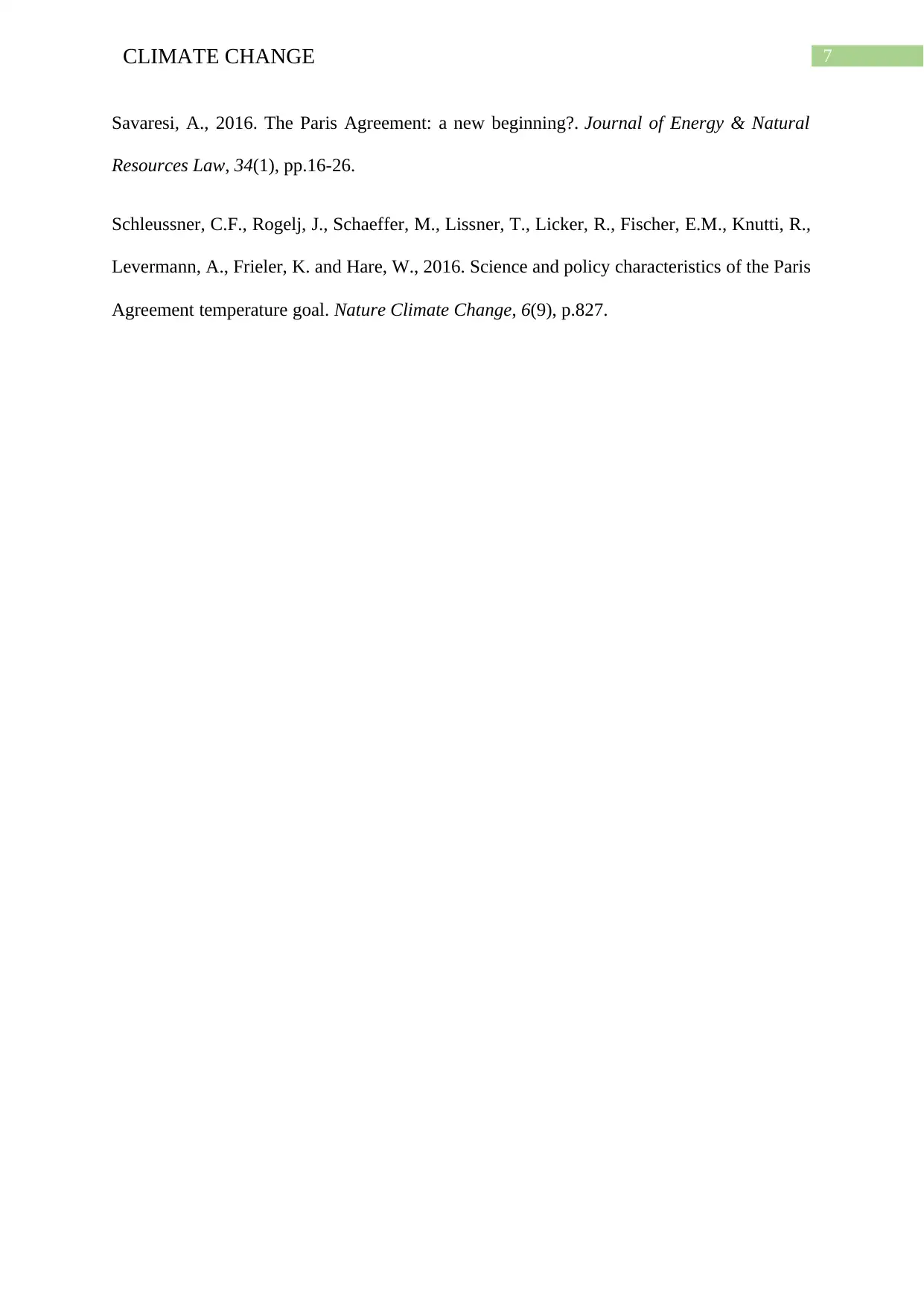
7CLIMATE CHANGE
Savaresi, A., 2016. The Paris Agreement: a new beginning?. Journal of Energy & Natural
Resources Law, 34(1), pp.16-26.
Schleussner, C.F., Rogelj, J., Schaeffer, M., Lissner, T., Licker, R., Fischer, E.M., Knutti, R.,
Levermann, A., Frieler, K. and Hare, W., 2016. Science and policy characteristics of the Paris
Agreement temperature goal. Nature Climate Change, 6(9), p.827.
Savaresi, A., 2016. The Paris Agreement: a new beginning?. Journal of Energy & Natural
Resources Law, 34(1), pp.16-26.
Schleussner, C.F., Rogelj, J., Schaeffer, M., Lissner, T., Licker, R., Fischer, E.M., Knutti, R.,
Levermann, A., Frieler, K. and Hare, W., 2016. Science and policy characteristics of the Paris
Agreement temperature goal. Nature Climate Change, 6(9), p.827.
1 out of 8
Related Documents
Your All-in-One AI-Powered Toolkit for Academic Success.
+13062052269
info@desklib.com
Available 24*7 on WhatsApp / Email
![[object Object]](/_next/static/media/star-bottom.7253800d.svg)
Unlock your academic potential
Copyright © 2020–2025 A2Z Services. All Rights Reserved. Developed and managed by ZUCOL.





